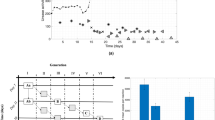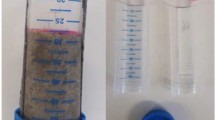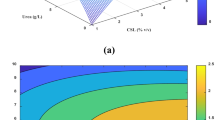Abstract
In order to reduce the cost of the microbial-induced carbonate precipitation, mixotrophic growth of Sporosarcina pasteurii was carried out at different yeast extract/sodium acetate concentrations and constant chemical oxygen demand for optimal production of urease enzyme. Optimization of cultivation conditions was also investigated using a 3-level central composite design approach based on the response surface methodology. A good agreement between predicted values of enzyme activity and experimental results was observed (R 2 value of 0.973). All three chosen independent variables had statistically great effects on the efficiency of urease activity. The maximum activity of 2.98 mM urea min−1 was achieved at yeast extract concentration of 5 g L−1, NH4 concentration of 9.69 g L−1, and incubation time of 60 h as the optimal conditions. Thereafter, a novel injection procedure as sequencing batch mode injection has been proposed for bacteria and cementation fluid injection at obtained optimal urease activity. After fourth injection of bacteria and cementation fluid, uniform CaCO3 distribution with unconfined compression strength of 795 kPa was obtained even for poorly graded sand. The presented experimental approach for optimizing urease activity and strength production in porous media can be used to design the treatment protocol for practical engineering applications.





Similar content being viewed by others
References
Achal V, Mukherjee A, Basu P, Reddy M (2009) Lactose mother liquor as an alternative nutrient source for microbial concrete production by Sporosarcina pasteurii. J Ind Microbiol Biotechnol 36:433–438
Aghaeinejad-Meybodi A, Ebadi A, Shafiei S, Khataee A, Rostampour M (2015) Degradation of antidepressant drug Fluoxetine in aqueous media by ozone/H2O2 system: process optimization using central composite design. Env Technol 36(12):1477–1488. doi:10.1080/09593330.2014.994041
Al Qabany A, Soga K, Santamarina C (2011) Factors affecting efficiency of microbially induced calcite precipitation. J Geotech Geoenviron Eng 138:992–1001
Alkhatib M, Mamun AA, Akbar I (2015) Application of response surface methodology (RSM) for optimization of color removal from POME by granular activated carbon. Int J Environ Sci Technol 12:1295–1302
Al-Thawadi S (2008) High strength in-situ biocementation of soil by calcite precipitating locally isolated ureolytic bacteria. Phd Thesis, Murdoch University
Al-Thawadi S, Cord-Ruwisch R, Bououdina M (2012) Consolidation of sand particles by nanoparticles of calcite after concentrating ureolytic bacteria in situ. Int J Green Nanotechnol 4:28–36
Bang S, Lippert J, Yerra U, Mulukutla S, Ramakrishnan V (2010) Microbial calcite, a bio-based smart nanomaterial in concrete remediation. Int J Smart Nano Mater 1:28–39
Barkouki T, Martinez B, Mortensen B, Weathers T, De Jong J, Ginn T, Spycher N, Smith R, Fujita Y (2011) Forward and inverse bio-geochemical modeling of microbially induced calcite precipitation in half-meter column experiments. Transp Porous Media 90:23–39
Cheng L, Cord-Ruwisch R (2012) In situ soil cementation with ureolytic bacteria by surface percolation. Ecol Eng 42:64–72
DeJong J, Martinez B, Mortensen B, Nelson D, Waller J, Weil M, Ginn T, Weathers T, Barkouki T, Fujita Y (2009) Upscaling of bio-mediated soil improvement. In: Proceedings of 17th international conference on soil mechanics and geotechnical engineering, 5–9 October 2009, Alexandria, Egypt. Millpress Science Publishers, Rotterdam, pp 2300–2303
DeJong JT, Mortensen BM, Martinez BC, Nelson DC (2010) Bio-mediated soil improvement. Ecol Eng 36:197–210
Din MM, Ponraj M, Van Loosdrecht M, Ujang Z, Chelliapan S, Zambare V (2014) Utilization of palm oil mill effluent for polyhydroxyalkanoate production and nutrient removal using statistical design. Int J Environ Sci Technol 11:671–684
Fujita Y, Taylor JL, Wendt LM, Reed DW, Smith RW (2010) Evaluating the potential of native ureolytic microbes to remediate a 90Sr contaminated environment. Environ Sci Technol 44:7652–7658
Hammes F, Boon N, Clement G, de Villiers J, Siciliano SD, Verstraete W (2003) Molecular, biochemical and ecological characterisation of a bio-catalytic calcification reactor. Appl Microbiol Biotechnol 62:191–201
Harkes MP, Van Paassen LA, Booster JL, Whiffin VS, van Loosdrecht M (2010) Fixation and distribution of bacterial activity in sand to induce carbonate precipitation for ground reinforcement. Ecol Eng 36:112–117
Kumar NM, Ramasamy R, Manonmani H (2013) Production and optimization of l-asparaginase from Cladosporium sp. using agricultural residues in solid state fermentation. Ind Crops Prod 43:150–158
Le Metayer-Levrel G, Castanier S, Orial G, Loubiere J-F, Perthuisot J-P (1999) Applications of bacterial carbonatogenesis to the protection and regeneration of limestones in buildings and historic patrimony. Sed Geol 126:25–34
Maddipati P, Atiyeh HK, Bellmer DD, Huhnke RL (2011) Ethanol production from syngas by Clostridium strain P11 using corn steep liquor as a nutrient replacement to yeast extract. Bioresour Technol 102:6494–6501
Maleki M, Ebrahimi S, Asadzadeh F, Tabrizi ME (2016) Performance of microbial-induced carbonate precipitation on wind erosion control of sandy soil. Int J Environ Sci Technol 13:937–944
Mortensen B, Haber M, DeJong J, Caslake L, Nelson D (2011) Effects of environmental factors on microbial induced calcium carbonate precipitation. J Appl Microbiol 111:338–349
Mousavi SM, Niaei A, Salari D, Panahi PN, Samandari M (2013) Modelling and optimization of Mn/activate carbon nanocatalysts for NO reduction: comparison of RSM and ANN techniques. Environ Technol 34:1377–1384
Naik SS, Setty YP (2014) Optimization of parameters using response surface methodology and genetic algorithm for biological denitrification of wastewater. Int J Environ Sci Technol 11:823–830
Nemati M, Voordouw G (2003) Modification of porous media permeability, using calcium carbonate produced enzymatically in situ. Enzym Microbial Technol 33:635–642
Nemati M, Greene E, Voordouw G (2005) Permeability profile modification using bacterially formed calcium carbonate: comparison with enzymic option. Process Biochem 40:925–933
Stabnikov V, Naeimi M, Ivanov V, Chu J (2011) Formation of water-impermeable crust on sand surface using biocement. Cem Concr Res 41:1143–1149
Van Paassen L, Harkes M, Van Zwieten G, Van der Zon W, Van der Star W, Van Loosdrecht M (2009) Scale up of BioGrout: a biological ground reinforcement method. In: Proceedings of the 17th international conference on soil mechanics and geotechnical engineering, pp 2328–2333
Van Paassen LA, Ghose R, Van der Linden TJ, Van der Star WR, Van Loosdrecht MC (2010) Quantifying biomediated ground improvement by ureolysis: large-scale biogrout experiment. J Geotech Geoenvironl Eng 136:1721–1728
Van Tittelboom K, De Belie N, De Muynck W, Verstraete W (2010) Use of bacteria to repair cracks in concrete. Cem Concr Res 40:157–166
Washbourne C-L, Renforth P, Manning D (2012) Investigating carbonate formation in urban soils as a method for capture and storage of atmospheric carbon. Sci Total Environ 431:166–175
Whiffin VS (2004). Microbial CaCO3 precipitation for the production of biocement. PhD Thesis, Murdoch University
Whiffin VS, Van Paassen LA, Harkes MP (2007) Microbial carbonate precipitation as a soil improvement technique. Geomicrobiol J 24:417–423
Acknowledgments
The authors thank Ahmad Sheikhbaglou (Biotechnology Research Center, Sahand University of Technology, Iran) for his valuable advice and help.
Author information
Authors and Affiliations
Corresponding author
Rights and permissions
About this article
Cite this article
Kakelar, M.M., Ebrahimi, S. Up-scaling application of microbial carbonate precipitation: optimization of urease production using response surface methodology and injection modification. Int. J. Environ. Sci. Technol. 13, 2619–2628 (2016). https://doi.org/10.1007/s13762-016-1070-8
Received:
Revised:
Accepted:
Published:
Issue Date:
DOI: https://doi.org/10.1007/s13762-016-1070-8




